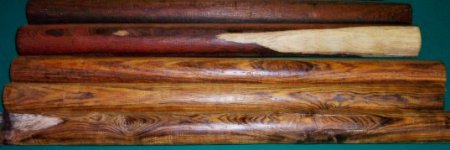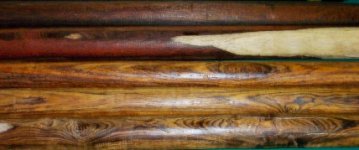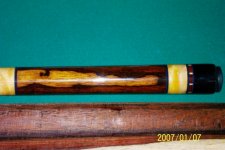I try to learn a little about different cue woods, and woods in general, so I will offer up a post here.
Rosewood is used a lot for different woods. Bubinga is called African rosewood sometimes. Some woods that are not true ebonies are called ebony. In general, I would prefer that to not be the case. It makes it harder to communicate with people and be sure of what each wood really is.
The last categories of scientific classification are Genus species.
Case in point, and several already pointed this out, cocobolo is Dalbergia retusa. Dalbergia is in the genus reserved for what are "true rosewoods". If a tree is in the Dalbergia genus, it is a rosewood. If it is not, it is not a rosewood, despite what it is called.
Lets look at a complete taxonomy heirarchy.
Kingdom - Phylum - Class - Order - Family - Genus - species.
You hear a lot of mention about so and so wood is in the same class or family as rosewood. I have heard someone advertising a certain wood as in the same class as ebony.

Well, Class is way the heck up the chain, and family is usually very very large by itself. There are probably hundreds of woods in the Genus Dalbergia, and thousands in the family that rosewoods belong in. Two trees/woods in the same family may be very very different, and making a comparison because of this IMO is weak. I feel it is at least in part a marketing strategy.
Someone mentioned granadillo. Well, the granadillo found in Mexico is in the Platymiscium genus. It is in the same family as rosewoods, but it is not a true rosewood. Calling it Dalbergia granadillo is only for marketing purposes. Some vendors may list it that way, but in my opinion they should not. It is either cocobolo, or granadillo, period.
There is another tree called granadillo found in the US, that is genus Caesilpinia. It is not the same granadillo in Mexico. Because there are common names shared, it is even more confusing when vendors call woods other woods for marketing.
Another example of rosewood that is not a rosewood is Bolivian rosewood. It is not a true rosewood, but Bolivian rosewood (Machaerium genus) sells better than Morado (its common name).
The persimmon tree has little commercial value other than as a fruiting ornamental. I am sure some of you are aware of this, but the persimmon tree is in the genus Diospyros. It is a true ebony, but because there is no real commercial value, it is not generally called ebony. Granadillo is sometimes called brown ebony, a rare tree from Brazil is called Brazilian ebony, a tree in deep south of Texas is called Texas ebony, and none of them are true ebonies. But because they are dark and hard, they are called ebony so people will say wow...ebony. Sometimes this cannot be helped, and sometimes the common name given to a tree bears that name from the beginning like Texas ebony. But in the case of calling Bubinga African rosewood, Bubinga already has a common name.
I am anal about it because when I see a wood in a cue, I want to know for sure what it is, and where it came from (sometimes vendors don't even know), so my apologies if this is too much info.



Kelly



